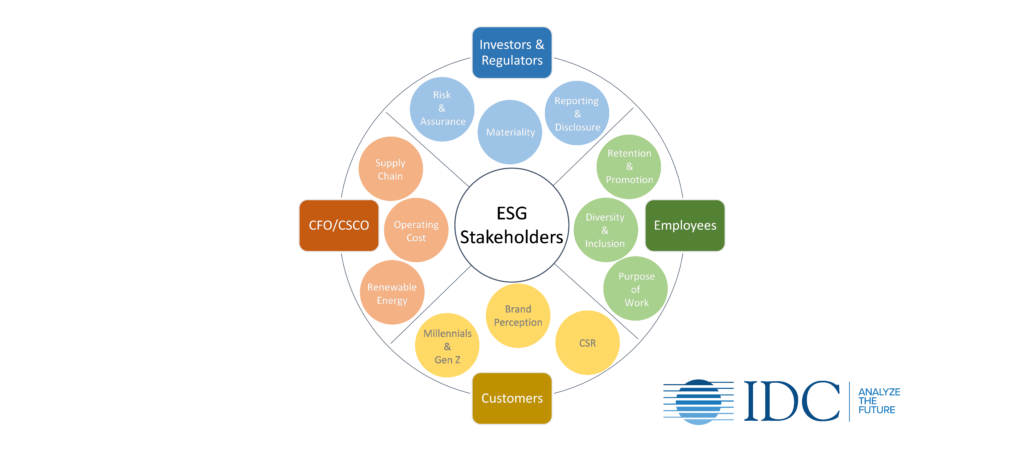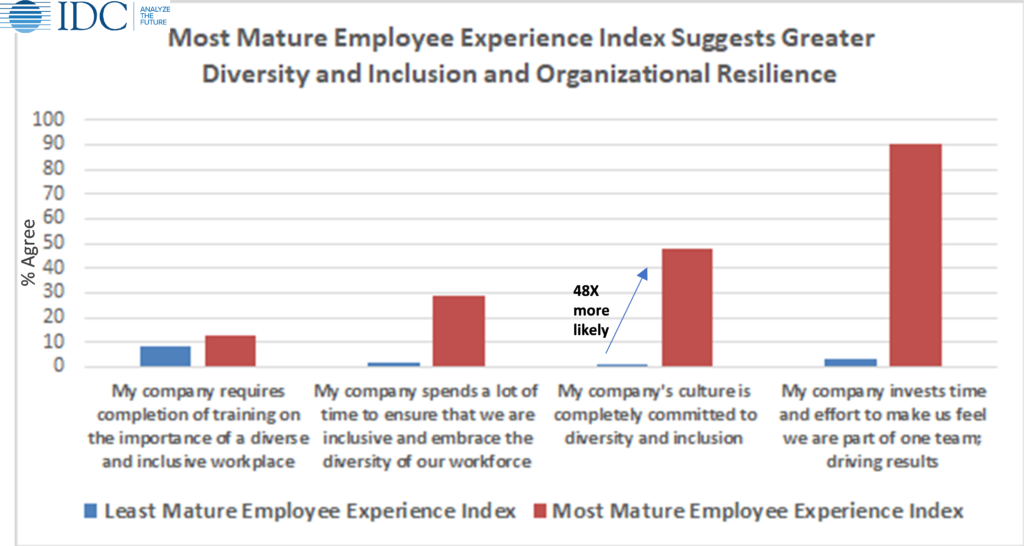The COVID-19 pandemic and social unrest have been further accelerating Environmental, Social, and Governance (ESG) investing and corporate sustainability practices. The employee experience, and Diversity and Inclusion (D&I) in particular, have gained attention as many companies are eager to transform their workforce approaches and create D&I measures that go beyond corporate statements and are truly impactful.
We want to take a closer look at the growing importance of ESG, not only from an investor perspective, but including a broader set of corporate stakeholders (most importantly employees),to assess how ESG frameworks can help companies measure and benchmark their D&I performance, and look at additional steps that enterprises can take to create meaningful employee experience programs.
The rise of ESG – What Does it Mean and Why is it Important?
ESG has become a dominating theme in the context of sustainable business conduct, primarily driven by a rapidly growing interest in sustainability from the investor community. Until recently, corporate social responsibility (CSR) was a seen as the cornerstone of companies’ sustainability efforts. Sustainability was mainly considered a normative component of (ethical) management behavior, i.e. conducting “good business”, without linking CSR measures directly to industry- or company-specific corporate performance aspects. This has changed in the context of ESG, which helps companies focus on sustainability criteria that are most essential for driving business outcomes, including D&I initiatives.
Over the last few years, the concept of materiality has gained importance in the ESG investment community. ESG-related materiality concepts shift the focus on ESG issues that have significant impact on companies’ enterprise value – their market capitalization, but also short- and long-term debt. An effective way to begin industry specific ESG materiality assessments is to use generally accepted frameworks.
The Sustainable Accounting Standards Board (SASB) foundation, for example, issues an ESG framework, which “identifies sustainability issues that are likely to affect the financial condition or operating performance of companies within an industry.” SASB’s Materiality Map lays out 26 sustainability-related business issues, e.g. air quality, customer welfare, employee engagement, diversity and inclusion, supply chain management, business ethics, etc.
While SASB’s materiality framework is primarily focused on investors’ needs through a macro-level (industry) lens, it is important for companies to cover the entire spectrum of stakeholders and their sometimes unaligned requirements. Besides investors and regulators, these stakeholders include employees, customers, and the CFO and CSCO. In the case of D&I programs, this is important because investors using the ESG materiality approach would consider the topic only material for industries that have been particularly impacted by D&I topics. However, IDC research shows that companies across all industries can benefit from D&I programs, when extending the ESG stakeholder view to their employees.

Why D&I and Why Now – Current Events Drive Focus on ESG’s “Social” Pillar
Both the COVID-19 pandemic and social unrest have put the spotlight on ESG’s “social” or “S-” pillar, which had largely been overshadowed by environmental and governance issues in the past. There is a new mandate for organizations to accelerate change by challenging existing policies and reinventing workforce strategies by focusing on the ESG issues covered with that pillar.
The focus on employees – not only in the context of human capital-related ESG issues from an investor perspective, but also as an ESG stakeholder group – is in the limelight, with new expectations for transparency and communications with the workforce. Organizations, led by the Chief Human Resources Officer (CHRO), must take this time to transform the culture of their companies by creating a community with integrated diversity and inclusion principles, that are supported at each stage of the employee lifecycle. IDC surveys confirm that organizational resilience during external stressors such as those we are experiencing, are met most successfully by companies that create a people-first, mature employee experience culture — ultimately creating long-term business value.
Creating a mature employee experience model, including an impactful D&I program, requires a series of steps:
- Companies need to assess the status quo of their D&I-related work. The ESG materiality approach can help companies as a starting point in identifying and quantifying relevant information, report and disclose this information, and benchmark their performance.
- Enterprises can then take the necessary steps to address shortcomings by focusing on communications, collaboration, mental well-being, and inclusion. Organizations that conduct regular employee listening and hear the employee “voice” by viewing employees as ESG stakeholders/employee activists will lay the foundation to deal with the current crises and those that occur in the future.
Diversity and inclusion initiatives are a significant component of the employee experience, with employees at organizations with mature employee experience models being 48x more likely to feel that their company’s culture is “completely committed to diversity and inclusion”.

Evaluating the Status Quo: What can Companies do to Assess their D&I Performance Using an ESG Approach?
The first step towards a formalized D&I approach is to quantify, report and disclose diversity- and inclusion-critical metrics, starting with the identification of a standardized way to capture and share relevant information. This process helps companies to get a better understanding of their own D&I performance by creating awareness and feedback for their efforts, and, eventually, getting credited in the form of ESG ratings. These external, third-party ratings can serve investors to make investment decisions and can be used internally by the rated firm to draw necessary conclusions about its own course.
A starting point for the identification and classification of material ESG issues can be found, for instance, in the SASB Materiality Map, which covers “Employee Engagement, Diversity and Inclusion” as part of its human capital-focused accounting metrics. Diversity- and inclusion-relevant assessment criteria take into account the percentage of gender and racial/ethnic group representation for executive and non-executive management, technical staff, and all other employees; percentage of technical employees who are H-1B visa (temporary US work visa) holders; percentage of employees that are foreign nationals/located off-shore; and total amount of monetary losses as a result of legal proceedings associated with employment discrimination.
The materiality of SASB’s accounting metrics differs across industries, but implications should also be assessed on a company-specific basis to cater to stakeholders beyond just the investor community.
As a number of different industry standards exist, and ESG rating firms and investors look at a diverse set of D&I metrics, it is useful for companies for gain a solid understanding of the different metrics that are being used in the industry.
While it might be too expensive and time-consuming for many companies to provide data on all the metrics used by different rating firms, a solid understanding of these rating criteria beyond the commonly used SASB categories can help pave the way towards a comprehensive and differentiating D&I initiative. This can include the reporting on policies or programs regarding health and sexuality, e.g. programs focusing on HIV/AIDS and metrics regarding lesbian, gay, bisexual, transgender and queer equality.
After the appropriate (material) D&I information has been identified, companies need to make sure they publish their data and make the information accessible to a broad set of external stakeholders. This is an important step in order to raise awareness for diversity and inclusion efforts, allow ESG rating agencies to produce more accurate (and likely better) assessments and ESG scores and, lastly, to then use these scores for internal benchmarking and improvement measures. Companies typically release information around diversity and inclusion on their websites or through dedicated reports, which are accessible online to the public.
Analysts at ESG rating agencies like MSCI and Sustainalytics will use this information for their regular updates of the ESG scores that these rating companies issue. The scores define which are the leading companies in each ESG category and serve as key metrics and inclusion criteria for ESG-focused investment funds. Companies can also work with ESG rating firms to receive scores for their internal use if they are not regularly being assessed regarding their D&I performance.
Improving Employee Experience and D&I Performance
So, what’s next? Assessing D&I performance is an important and oftentimes overlooked step. But once companies have a better understanding of their D&I efforts’ relative performance, they can undertake next steps to improve their measures in a targeted way.
The pandemic has created a turning point for ESG and specifically D&I initiatives. Organizations have an opportunity to reinvent their workforce and cultural strategies. The role of the CHRO has gained significance during the pandemic, and in many cases the CHRO is viewed as a key architect of the culture of the organization and as the “conscience of the Board”. Now is the time to focus on the employee stakeholders driving the social pillar of the ESG program.
During this time of social unrest and calls to identify and end systemic racism, organizations may want a “quick” technology fix to check it off their list. There are technologies that can be put in place to help with D&I initiatives, including continuous listening, engagement surveys with an inclusion focus, communication and collaboration technologies. However, the real work is assessing the culture of the organization to ensure inclusivity; while deploying enabling tools to gain deeper insights as to gaps, issues and to create action plans for improvement.
The most mature D&I organizations integrate their D&I initiatives into the mainstream workflow of the organization and through-out the entire employee lifecycle – from onboarding to off-boarding and everything in between to ensure inclusion and equity at every stage.
Organizations can use existing workforce/human capital management systems to provide these data insights at each point of an employee’s lifecycle. Organizations need to look at metrics at each stage of the lifecycle to ensure that there is goal alignment and marked improvements on an on-going basis. This will be the most effective way to combat systemic racism and not to simply check-off boxes that hiring and demographic needs have been met. Data points of interest will answer questions such as: do all employees have the same career opportunities; the same upskilling and learning opportunities; equitable compensation; consistent attrition and retention rates; and more.
In conjunction with using the operational data described above, organizations should also use employee engagement continuous listening techniques to constantly gauge employee sentiment regarding D&I initiatives and feelings about the inclusivity of the culture. These data sets, both operational and survey-based, can be used to analyze any patterns that exist through the employee lifecycle to help eliminate bias.
In summary, organizations should capture or use existing human capital data to assess their current metrics in a structured way using established frameworks and then apply diversity and inclusion best practices to create a people-first, one team culture.
Technology has proven to be critical to enabling businesses’ responses to the COVID-19 pandemic. Explore how organizations will leverage technology long-term as they move from crisis to recovery and journey to the next normal with IDC’s extensive COVID-19 research and advice.
Laura Becker, Research Manager for Employee Experience, also contributed to this piece.




